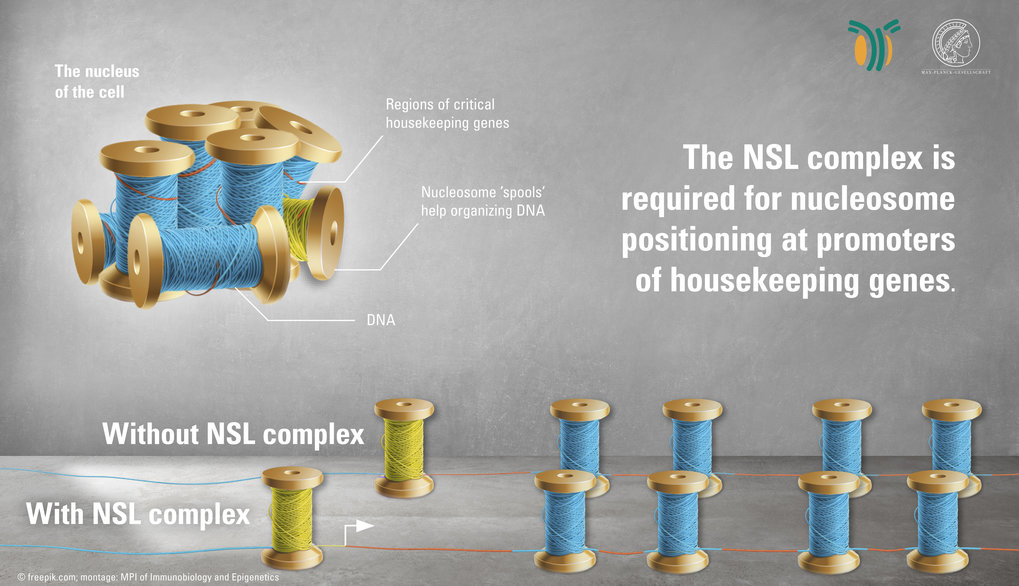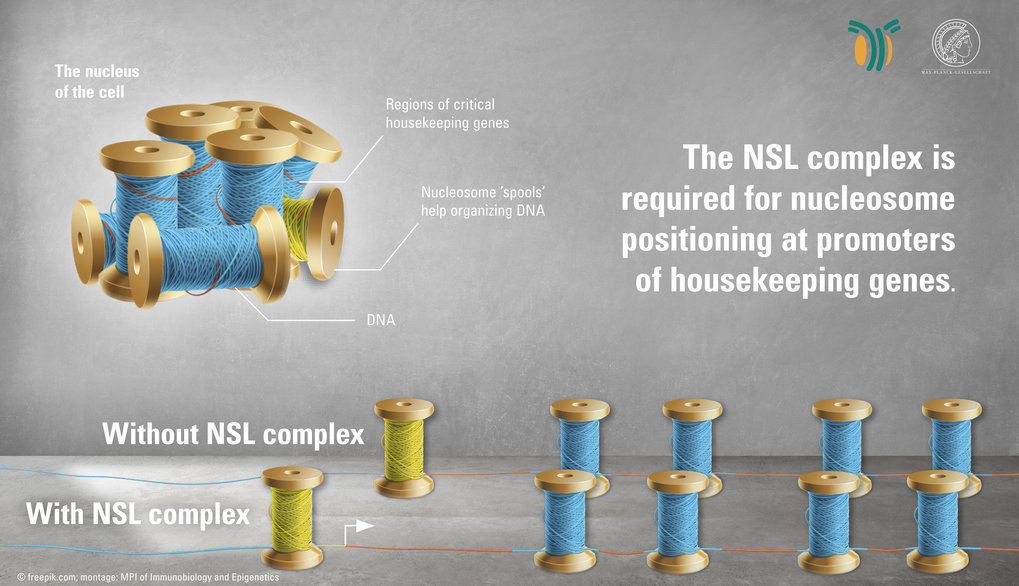Who keeps an eye on the house keeper?
Max Planck researchers reveal how the DNA is made accessible for gene transcription
It is essential for our cells that the genes on the chromosomes are expressed in the correct dose in each cell type. This also applies to the so-called housekeeping genes, which are necessary for the maintenance of the basic functions of each cell. Researchers at the Max Planck Institute for Immunobiology and Epigenetics now have succeeded in showing how transcription is started, especially with household genes, and how the required level of gene dose can be maintained. The study uses the fruit fly Drosophila as an example to show how a highly conserved protein complex called NSL positions the nucleosomes in such a way that it is possible for the cell to start reading the genes and control the level of gene expression.

In our bodies, there are more than 200 different cell types. Cells take on their identities by switching on distinct sets of genes. But specific genes have to be transcribed in every cell. Scientists refer to them as ‘housekeeping genes’ because their are required for supporting basic cellular function such as metabolism. However, as every organ and cell type is functionally unique, they need a different dose of each active gene to meet their individual requirements. Moreover, a deregulation of these processes can lead to severe health problems or cancer.
Despite decades of research, scientists still do not fully understand how precise levels of gene expression are maintained at the molecular level. Researchers in the lab of Asifa Akhtar, director at the Max Planck Institute of Immunobiology and Epigenetics, have been addressing precisely this question and show in their recent study how the critical housekeeping genes are turned on.
Orderly nucleosomes for optimal gene transcription
The team unveils that the “NSL” molecular machinery prepares the genes for activation. DNA is wrapped around histone proteins like a thread around a spool. Each of this spool with the thread is called nucleosome. Nucleosomes are good at packaging and protecting the long DNA, but when the DNA needs to be accessible, the spool has to be reorganized. The NSL complex helps arrange these “spools” around the “thread”, so that the DNA template can be read and comprehended by the cell. “The complex acts like a supervisor. “The complex creates orders exactly at the point that is important for starting the transcription process of housekeeping genes”, explains Ken Lam, first-author of the study. “Imagine that thousands of “spools” need to be precisely ordered for the DNA to be read properly. With the NSL complex, “spools” are positioned in their designated place so that you can use the “thread” in between and space is optimally used. In this orderly manner, it is easier to control the level and precision of the gene expression. Without the NSL, the “spools” are just all over the place on the “thread”, and it becomes confusing which part of the thread should be used.”
Understanding human disease
By gaining a better understanding of how the NSL complex allows the DNA to be read, the Max Planck researchers are convinced that this could mean considerable progress in our understanding of severe diseases such as the Koolen-de Vries syndrome. This syndrome is a rare genetic disorder characterized by developmental delay and intellectual disability. Patients show learning difficulties and other health concerns such as epilepsy or heart defects.
The syndrome is caused by the loss of a part of chromosome 17, including the KANSL1 gene, or by a mutation in the KANSL1 gene. “This gene is part of the NSL complex. If one copy of the gene gets lost, cells cannot produce the correct gene dosis anymore and the NSL complex cannot work properly. However, the molecular functions of this gene defect are mostly unknown,” says Asifa Akhtar.
The NSL complex emerges as an important transcription regulator for a vast number of housekeeping genes, and thus is crucial for maintaining cellular homeostasis. The scientists are convinced that determining the functions of these transcription factors at the most fundamental level is critical for the understanding of disease. “We hope our work will allow scientists to better interpret the molecular changes and consequences of NSL complex loss or dysfunction in developmental disorders such as the Koolen-de Vries syndrome,” says Asifa Akhtar.
